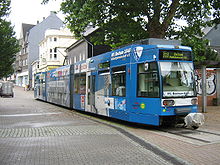
The Ruhr, also referred to as the Ruhr area, sometimes Ruhr district, Ruhr region, or Ruhr valley, is a polycentric urban area in North Rhine-Westphalia, Germany. With a population density of 2,800/km2 and a population of over 5 million (2017), it is the largest urban area in Germany. It consists of several large cities bordered by the rivers Ruhr to the south, Rhine to the west, and Lippe to the north. In the southwest it borders the Bergisches Land. It is considered part of the larger Rhine-Ruhr metropolitan region of more than 10 million people, which is the third largest in Europe, behind only London and Paris.

The Rhine-Ruhr metropolitan region is the largest metropolitan region in Germany, with over ten million inhabitants. A polycentric conurbation with several major urban concentrations, the region covers an area of 7,110 square kilometres (2,750 sq mi), entirely within the federal state of North Rhine-Westphalia. The Rhine-Ruhr metropolitan region spreads from the Ruhr area (Dortmund-Bochum-Essen-Duisburg) in the north to the urban areas of the cities of Mönchengladbach, Düsseldorf, Wuppertal, Leverkusen, Cologne, and Bonn in the south. The location of the Rhine-Ruhr at the heart of the European Blue Banana makes it well connected to other major European cities and metropolitan areas such as the Randstad, the Flemish Diamond and the Frankfurt Rhine Main Region.
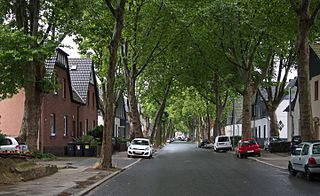
Leithe is the northwesternmost part of the city of Bochum in the Ruhr area in North Rhine-Westphalia in Germany. The population used to speak Westphalian, but now standard German is the norm. Leithe borders onto a part of the city of Essen also bearing the name of Leithe. Leithe belongs to the Stadtbezirk of Wattenscheid. When the last census was held in 1987, Leithe had the third highest share of Roman Catholics in Wattenscheid and Bochum overall.

Höntrop is a district of the City of Bochum in the Ruhr area in North Rhine-Westphalia in Germany. The population used to speak the Westphalian dialect, but now standard German is the norm. Höntrop borders inter alia to Freisenbruch, which belongs to Essen, another city, and Linden a district of Bochum. Höntrop belongs to the Stadtbezirk of Wattenscheid. Höntrop is a stop at the railway line S1 to Solingen via Düsseldorf and furthermore also to Dortmund and is starting- and endpoint of the tram line 310 to Heven, a part of Witten via the city of Bochum and Bochum main station.

Bochum-Linden is a district of the City of Bochum in the Ruhr area in North Rhine-Westphalia in Germany. The population's main language was once Westphalian, but it has since been replaced by High German. Bochum-Linden is located in the south west of Bochum, between Dahlhausen and Stiepel. It shares a border with Hattingen, a city of Ennepe-Ruhr-Kreis.

Wattenscheid is a Stadtbezirk of the city of Bochum. Until 1975, it was a separate town in the Ruhr area of North Rhine-Westphalia. Wattenscheid has a population of about 80,000 citizens. Some notable firms have their headquarters in there, such as Steilmann.
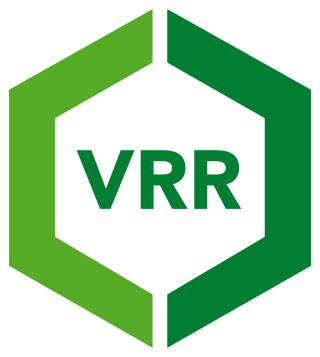
The Verkehrsverbund Rhein-Ruhr, abbreviated VRR, is a public transport association (Verkehrsverbund) in the German state of North Rhine-Westphalia. It covers most of the Ruhr area, as well as neighbouring parts of the Lower Rhine region, including Düsseldorf and thus large parts of the Rhine-Ruhr conurbation. It was founded on 1 January 1980, and is Europe’s largest body of such kind, covering an area of some 5,000 km2 (1,900 sq mi) with more than 7.8 million inhabitants, spanning as far as Dorsten in the north, Dortmund in the east, Langenfeld in the south, and Mönchengladbach and the Dutch border in the west.

The Bochum-Gelsenkirchener Straßenbahnen AG, abbreviated BOGESTRA, is a public transport operator in the Ruhr area, most notably in the cities of Bochum, Gelsenkirchen and Herne. As of 2012, the company operated, in whole or in part, 9 rail lines, and 65 bus lines. In 2012, BOGESTRA transported a total of 144.9 million passengers. The company is a member of the Verkehrsverbund Rhein-Ruhr (VRR) public transport association.

The Eisenbahnmuseum Bochum-Dahlhausen is a railway museum situated south of the city of Bochum in the state of North Rhine-Westphalia, Germany. It was founded by DGEG, the German Railway History Company in 1977 and is based in a locomotive depot that was built between 1916 and 1918 and ceased operation in 1969. Then DGEG took over the whole area of 46,000 square metres and built up the biggest railway museum in Germany. In the middle of the museum, there is an engine shed with fourteen tracks. A preserved turntable, coaling, watering, and sanding facilities are still in operation. This museum is integrated into The Industrial Heritage Trail a route of monuments from the history of the industry.

The Industrial Heritage Trail links tourist attractions related to the industrial heritage in the Ruhr area in Germany. It is a part of the European Route of Industrial Heritage. The series of routes were developed between 1989 and 1999, however additions are still being made.

Line S3 is a S-Bahn in the Rhein-Ruhr network. It runs from Oberhausen over Essen to Hattingen Mitte. It is operated at 30-minute intervals, using Stadler FLIRT 3XL units.
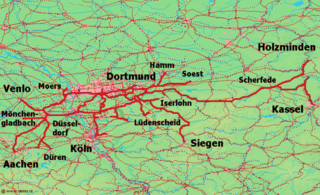
The Witten/Dortmund, Oberhausen/Duisburg railway is one of the most important railways in Germany. It is the main axis of long distance and regional rail transport on the east–west axis of the Ruhr and is served by Intercity-Express, InterCity, Regional-Express, Regionalbahn and S-Bahn trains.
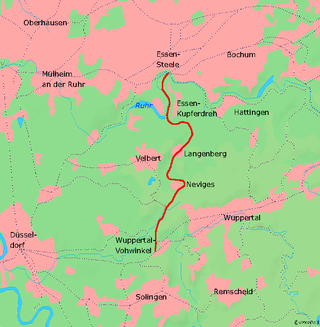
The Wuppertal-Vohwinkel-Essen Überruhr Railway is a 30 km (19 mi) long, continuous two-track electrified main line. It is known as the Prince William Railway, the first railway linking the valleys of the Wupper and the Ruhr.

The Ruhr Valley Railway is a partly abandoned railway line in the German state of North Rhine-Westphalia, running from Düsseldorf-Rath via Old Kupferdreh station, Bochum-Dahlhausen, Witten-Herbede, Hagen-Vorhalle and Schwerte to Warburg. It was built between 1872 and 1876 by the Bergisch-Märkische Railway Company, one of the three major private railway companies in the Ruhr area. The railway tracks that were built along the Ruhr river had a relatively uniform grade that was suitable for railway operations at the time.

Essen-Steele is located in the district of Essen-Steele in the German city of Essen in the German state of North Rhine-Westphalia. It is on the Witten/Dortmund–Oberhausen/Duisburg line and is classified by Deutsche Bahn as a category 4 station. It is served by the RB 33 (Rhein-Niers-Bahn) Aachen / Heinsberg, RE 49 (Wupper-Lippe-Express) and Rhine-Ruhr S-Bahn lines S1, S3 and S9.

Essen-Steele Ost station is located in the district of Essen-Steele in the German city of Essen in the German state of North Rhine-Westphalia. It is on the Witten/Dortmund–Oberhausen/Duisburg line and is classified by Deutsche Bahn as a category 4 station. It is served by Rhine-Ruhr S-Bahn lines S 1 and S 3.
The Essen-Ruhr-Bochum-Langendreer railway is a railway line in the Ruhr region of the German state of North Rhine-Westphalia. Part of it is now disused.
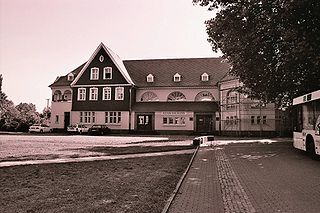
Bochum-Dahlhausen station is located in the Dahlhausen district of Bochum in the German state of North Rhine-Westphalia. The station building dates from the time of the First World War.

Bochum-Langendreer station is now a stop on the Rhine-Ruhr S-Bahn in the district of Langendreer in eastern Bochum in the German state of North Rhine-Westphalia. Langendreer formerly had a 40 hectare marshalling yard, which is now used as a depot, with the location code of EBLA. Until the 1980s, the yard was also the location of a passenger station, which was served by express trains.
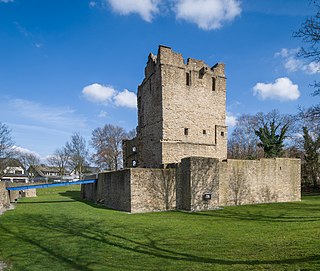
Burgaltendorf is a southeastern borough of the city of Essen in North Rhine-Westphalia in Germany. When the former independent municipality of Altendorf (Ruhr) was incorporated into the city in 1970, it was renamed into Burgaltendorf to avoid confusion with the northwestern Essen borough of Altendorf. The borough Burgaltendorf is named after Castle Altendorf, which was built here in the 2nd half of the 12th century, probably between 1160 and 1180.
